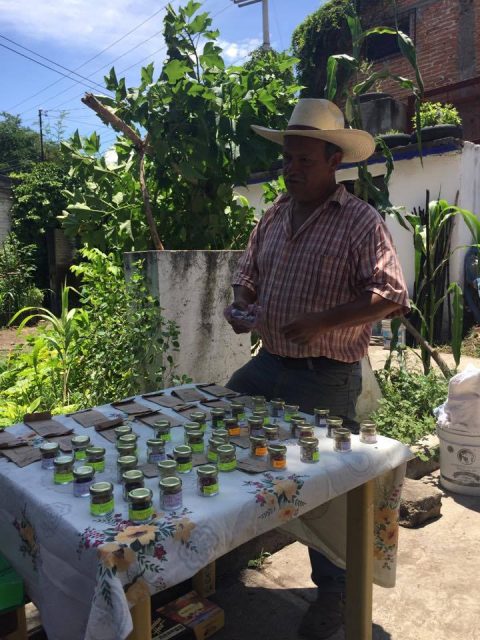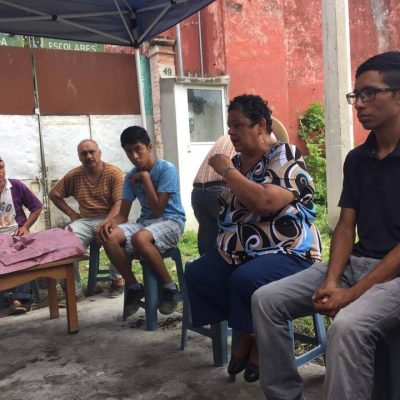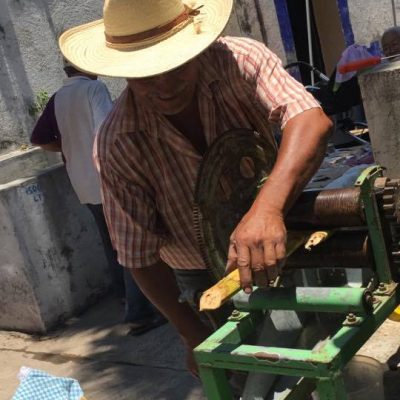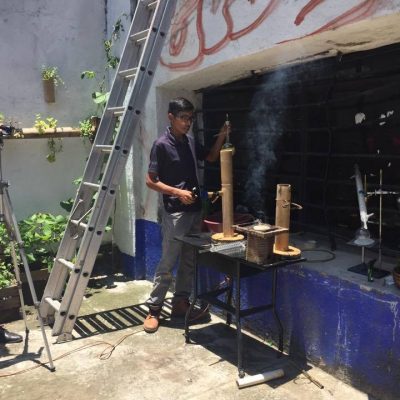Por: Luisa Montes (Ciudades Verdes) English follows
Tenextepango Morelos posee una hacienda quefue de la comunidad, actualmente ha sido privatizada y su uso poco tiene que ver con su otrora función; la repartición y uso de las tierras sigue siendo un tema pendiente en esta entidad campesina por derecho y tradición.
– “La hacienda la perdimos, pero la bodega la recuperamos…”
Aproximadamente veinte metros cuadrados de tierra fértil sirven de umbral a una vieja bodega que ha sido tienda de raya, cine, albergue para cortadores de caña o para hijos de jornaleros agrícolas; el recinto abandonado por largo tiempo está siendo recuperado a partir de la iniciativa de Sergio Ortiz Fernández, lugareño comprometido con el campo, para convertirla en la La casa ejidal de la cultura. A esta propuesta se sumaron tres estudiantes de la UPN Ayala a través de la figura de reto sustentable, medida estratégica nacida del proyecto Planteles Educativos Sustentables con la intención de apoyar desafíos que aporten a favor de la sustentabilidad en espacios educativos; de a poco, se integraron estudiantes de suelo y fertilizantes de UAEM, el IPRO y otras universidades locales, además de integrantes de la comunidad y visitantes espontáneos que fortalecen con talleres de capacitación al grupo que se ha creado en torno de este lugar.
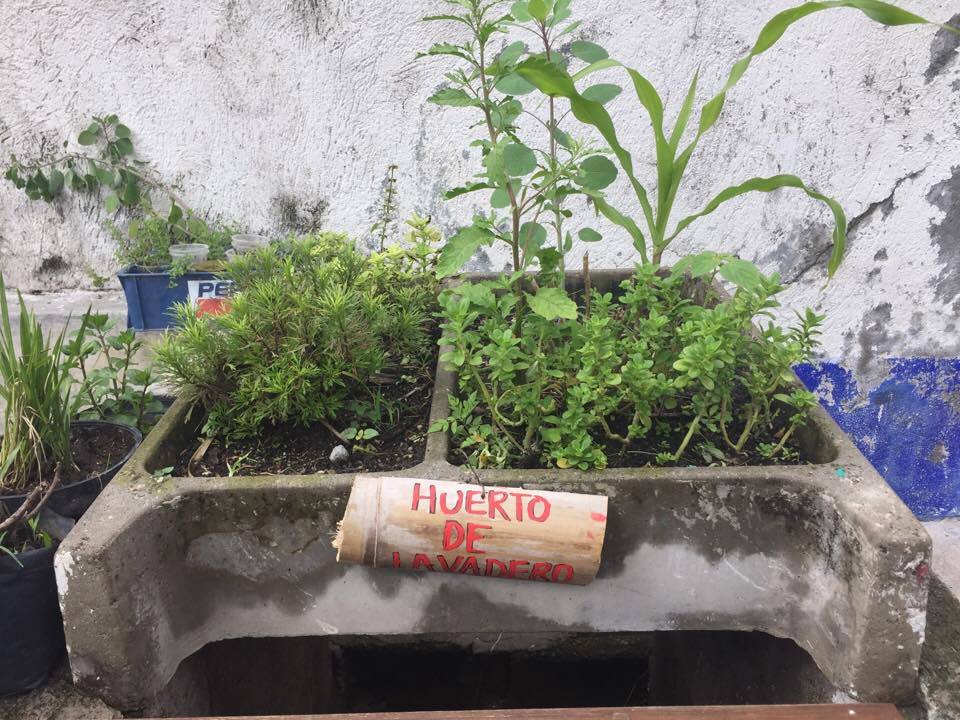
La casa ejidal de la cultura impulsa actividades relacionadas con el desarrollo cultural de la comunidad, principalmente acciones agrícolas y técnicas de permacultura. Uno de los objetivos principales es rescatar el concepto milpa que se ha venido perdiendo y es diferente a simplemente sembrar maíz; en una milpa además del maíz debe haber otros cultivos, ya sea calabaza, chile o frijol; puede llegar a tener hasta treinta cultivos en el lapso de cuatro meses en que está lista la mazorca, entre ellos: rábano, cilantro, pápalo, verdolaga, calabaza, ejote, frijol y otros, sin usar herbicidas porque de lo contrario no desarrolla otros cultivos. El concepto es tan amplio como las necesidades y los objetivos de cada familia y eso es lo que se busca rescatar. Una milpa atrae especies de animales como patos, chivos y borregos que se ven beneficiados al tiempo que ayudan a mantenerla limpia y sana.
La milpa es la metáfora ideal para hablar de otro concepto valioso, el bienestar común, una consecuencia paralela a las prácticas sustentables en comunidad, alrededor del también llamado oro amarillo; plantas, aves, insectos, animales, personas y medio ambiente van encontrando un engranaje casi mágico que hace emerger la esperanza. Por su parte, el conocimiento empírico y científico tomados de la mano aportan herramientas y desarrollan habilidades para seguir construyendo espacios donde al final, el ambiente emocional pasa por la sensación de pertenencia, de respeto y de paz.
Las estudiantes de la UPN como interventoras educativas son conscientes de que la escuela no es el único ni el más eficiente espacio de aprendizaje y educación, reconocen que el rescate y conocimiento de prácticas tradicionales apoyadas con conocimiento científico fortalecen el sentido de identidad y el compromiso a la preservación. Y eso, es sin duda una maravillosa manera de cumplir un reto. Enhorabuena.
Blog basado en entrevistas realizadas a los integrantes del Proyecto en Tenextepango Morelos con alumnas UPN Ayala que desarrollaron el Reto: Karen Espinosa, Kenya Real y Ahylinn Meza el 11 de julio de 2017
All can be grown in my garden, if I know how to organize it…
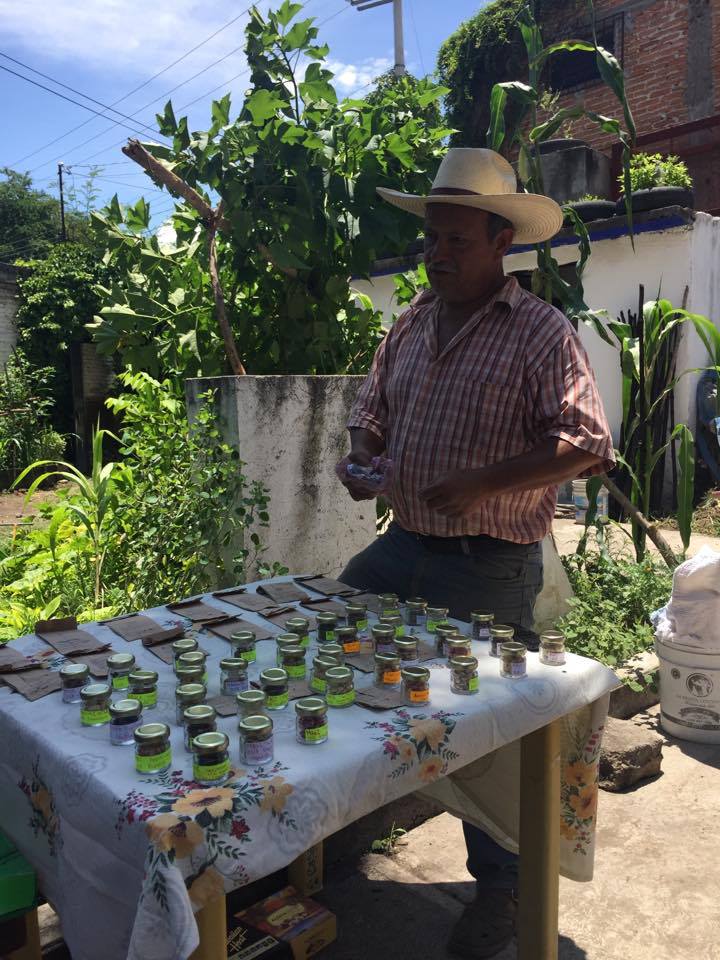
By: Luisa Montes (Ciudades Verdes)
Translation by Abril Obregon
Tenextepango Morelos has a warehouse that belonged to the community. It has now been privatized and its use has little to do with its former function; the distribution and use of land remains a pending issue in this peasant community ruled by rights and traditions.
– “We lost the hacienda (ranch) but we recovered the warehouse …”
Approximately twenty square meters of fertile land serve as the threshold for an old warehouse that has been a store, a cinema, a shelter for cane cutters and for children of agricultural laborers; the long-abandoned site is being recovered with the initiative of Sergio Ortiz Fernández, a villager committed to the countryside, to turn it into the “casa ejidal de la cultura” (community cultural centre). Three students from the UPN Ayala joined this project through the figure of a Sustainable Challenge, a strategic measure born from the Sustainable Campuses Initiative, an initiative with the intention of supporting projects that contribute to sustainability in educational spaces; Little by little, students of the “Soils and fertilizers degree” from the UAEM, IPRO and other local universities joined, as well as members of the community and other visitors who together strengthen the group that gathers around this place with engage in training workshops.

The “casa ejidal de la cultura” promotes activities related to the cultural development of the community, mainly agricultural actions and permaculture techniques. One of the main objectives is to rescue the tradition of the milpa which has been lost and is different from simply planting corn; In a milpa, in addition to corn, there must be other crops, such as squash, chili peppers or beans; it can yield up to thirty crops in a period of four months in which the corn is ready, among them: radish, coriander, papalo, purslane, squash, green beans, beans and others, without using herbicides because otherwise it does not develop other crops. The concept is as broad as the needs and objectives of each family and that is what is sought to be rescued in this space. A cornfield attracts species of animals such as ducks, goats and sheep that benefit from it while helping to keep it clean and healthy.
The milpa is the ideal metaphor to talk about another valuable concept, well-being for all, a parallel consequence from community based sustainable practices. Around the also called yellow gold; plants, birds, insects, animals, people and the environment find an almost magical synchronicity that makes hope emerge. For their part, empirical and scientific knowledge, hand in hand, provide tools and develop skills to continue building spaces where in the end, the emotional environment passes through the feeling of belonging, respect and peace.
The students of the UPN, as educational actors, are aware that school is not the only or the most efficient space for learning and educating. They recognize that the recovering traditional practices, supported with scientific knowledge, can strengthen the sense of identity and the commitment to conservation and that is certainly, a wonderful way to carry out a project. Congratulations!
Blog based on interviews with the members of the Project in Tenextepango Morelos with UPN Ayala students who developed the Challenge: Karen Espinosa, Real Kenya and Ahylinn Meza on July 11, 2017

